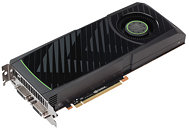Monday, July 3rd 2017

NVIDIA Adds DirectX 12 Support to GeForce "Fermi" Architecture
With its latest GeForce 384 series graphics drivers, NVIDIA quietly added DirectX 12 API support for GPUs based on its "Fermi" architecture, as discovered by keen-eyed users on the Guru3D Forums. These include the GeForce 400-series and 500-series graphics cards. The support appears to be sufficient to run today's Direct3D feature-level 12_0 games or applications, and completes WDDM 2.2 compliance for GeForce "Fermi" graphics cards on Windows 10 Creators Update (version 1703), which could be NVIDIA's motivation for extending DirectX 12 support to these 5+ year old chips. Whether they meet your games' minimum system requirements is an entirely different matter.
Source:
Guru3D Forums

58 Comments on NVIDIA Adds DirectX 12 Support to GeForce "Fermi" Architecture
It would simply freeze up all the time, either during installation or the short moments I was in windows it would freeze up as well...
Also 3DMark says my GTX470 doesn't have enough memory and may not complete TimeSpy.
AMD was very clear from the beginning saying only GCN will have it, and the best of all is Intel, giving support to Ivy Bridge and up.
wccftech.com/amd-confirms-gcn-cards-feature-full-directx-12-support-feature-level-111-gcn-10-feature-level-120-gcn-1112/
Also, I'm sorry W1zzard.... ("fix" needs to be fixed) : LINK.
Scores for my GTX 580 Lighting (1,5GB) :
Time Spy : LINK (Score : 962)
API Overhead test 2.0 : LINK
Gears of War 4* :
*have a problem with resolution scaling lock... (trying to fix).
Many still use Fermi hardware, even I have one in daily use. But it seems that all of you have missed the most important part of this news; accelerating the adoption of new APIs. Even those who don't own a Fermi card should be really happy about this, since it removes the last reason for developers to spend resources on pre-Direct3D 12 APIs. Accelerating the adaptation of new APIs serves everyone, even if the new APIs don't show their full potential on old hardware. This is something worth celebrating.
Don't forget how Nvidia drops performance optimizations on older generations of "supported" cards, you get a new driver with Fermi or Kepler, but don't expect those 50% improvements in the notes to apply to your card. Personal experience with a, at the moment, "supported" 7600GT.
The reason why Nvidia are able to implement Direct3D 12 on Fermi, even though it's very different from Kepler, is the fact that there are very few new hardware requirements from Direct3D 11 to 12 (base requirements). Since Fermi is using different modules internally in the driver, most of the support had to be rewritten from scratch, and since it's a low-priority issue it has taken some time. But Direct3D 12 will never work as well on Fermi as compared to newer architectures.
DX12 is DX11 with a low overhead design, that is why it can be implemented on old DX11 hardware, same as with Vulkan, can be implemented on anything that can run OpenGL 4.2 (we are at 4.5+). On the other hand, DX11 is a bunch of extensions on top of DX10, if you want to run DX11 apps on a card designed for DX10, you have to CPU emulate them, with the corresponding performance penalty, that is why it's not possible to make a 8800GT or an HD3850 run DX11.Old architectures don't even get game optimizations, practically a zombie in the drivers. It's not different from having a fixed old driver. DX12 is not a "new feature", it was promised years ago, and is very late compared to the rest of the supported archs.
Nevertheless, they add support for new versions of operating systems, both for Windows, Linux and BSD.Fermi is using a different code path from Kepler and newer, so it is a new feature for the Fermi driver. There is a reason why Nvidia's Direct3D 12 performance has improved a lot since its first introduction, it's due to tweaking their API implementation in the specific driver code paths. Creating optimal code paths for Vulkan, Direct3D and OpenGL for each architecture are the optimizations that matter, this benefits all software, unlike random (stupid) tweaks to a shader program of a specific game which might help them 7% in that edge case.
To everyone saying AMD 7xxx supported DX12 from the start unlike Fermi. Fermi was released about the same time as AMD 5xxx series of GPUs, which still do not support DX12, fwiw.
On a more serious note, it's nice to see hardware that's been out of production for more than five years get a feature boost. It understandably doesn't happen often (poor return on investment). Now to find a decent DX12 game that can run on a 560 Ti... oh wait, I'm not on Win10. So much for that I guess. Still nice to see this though.
Imho they rate with the 5800 and 2900.
AMDs 5870/5850 were on market for half a year, before first Fermi was released (September 2009 vs. March 2010).
So, a fair comparison would be between it and Radeons of HD 6000 series.
Still, Radeons can't have DX12 support because doing it for VLIW5/4 based architectures is too expensive and not necessary at this point from AMD point of view.
I'm really glad NV added DirectX 12 to Fermi, because it means you don't need a PCI-e 3.0 GPU to have it :)